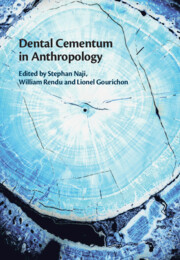Book contents
- Dental Cementum in Anthropology
- Dental Cementum in Anthropology
- Copyright page
- Dedication
- Contents
- Contributors
- Foreword
- Introduction: Cementochronology in Chronobiology
- Part I The Biology of Cementum
- Part II Protocols
- 9 Cementochronology for Archaeologists: Experiments and Testing for an Optimized Thin-Section Preparation Protocol
- 10 Optimizing Preparation Protocols and Microscopy for Cementochronology
- 11 Cementochronology Protocol for Selecting a Region of Interest in Zooarchaeology
- 12 Tooth Cementum Annulations Method for Determining Age at Death Using Modern Deciduous Human Teeth: Challenges and Lessons Learned
- 13 The Analysis of Tooth Cementum for the Histological Determination of Age and Season at Death on Teeth of US Active Duty Military Members
- 14 Preliminary Protocol to Identify Parturitions Lines in Acellular Cementum
- 15 Toward the Nondestructive Imaging of Cementum Annulations Using Synchrotron X-Ray Microtomography
- 16 Noninvasive 3D Methods for the Study of Dental Cementum
- Part III Applications
- Index
- Plate Section (PDF Only)
- References
13 - The Analysis of Tooth Cementum for the Histological Determination of Age and Season at Death on Teeth of US Active Duty Military Members
from Part II - Protocols
Published online by Cambridge University Press: 20 January 2022
- Dental Cementum in Anthropology
- Dental Cementum in Anthropology
- Copyright page
- Dedication
- Contents
- Contributors
- Foreword
- Introduction: Cementochronology in Chronobiology
- Part I The Biology of Cementum
- Part II Protocols
- 9 Cementochronology for Archaeologists: Experiments and Testing for an Optimized Thin-Section Preparation Protocol
- 10 Optimizing Preparation Protocols and Microscopy for Cementochronology
- 11 Cementochronology Protocol for Selecting a Region of Interest in Zooarchaeology
- 12 Tooth Cementum Annulations Method for Determining Age at Death Using Modern Deciduous Human Teeth: Challenges and Lessons Learned
- 13 The Analysis of Tooth Cementum for the Histological Determination of Age and Season at Death on Teeth of US Active Duty Military Members
- 14 Preliminary Protocol to Identify Parturitions Lines in Acellular Cementum
- 15 Toward the Nondestructive Imaging of Cementum Annulations Using Synchrotron X-Ray Microtomography
- 16 Noninvasive 3D Methods for the Study of Dental Cementum
- Part III Applications
- Index
- Plate Section (PDF Only)
- References
Summary
Tooth Cementum Annulation Analysis (TCA), or Cementochronology, has been evolving over recent years with great potential for applied forensic sciences. The goals of this research is to evaluate if TCA can be used to accurately determine the chronological age at time of death and season at time of death for unaccounted for US service members and in forensic anthropology in general. Fifty teeth were processed, and analyzed by two independent observers for age and season at time of death estimations. Results indicate an average of 85% estimation success within a ±4 years range of documented chronological age. The last band of cementum was identified to the correct season in average 74%, with an interobserver agreement of 78%. This pilot study thus supports age at death estimation using TCA in forensic contexts, and suggests additional validation studies for season of death estimation.
- Type
- Chapter
- Information
- Dental Cementum in Anthropology , pp. 226 - 233Publisher: Cambridge University PressPrint publication year: 2022



